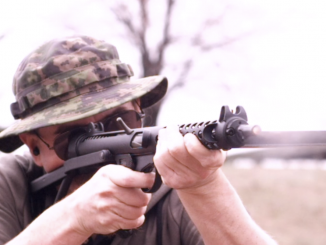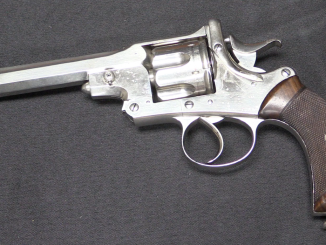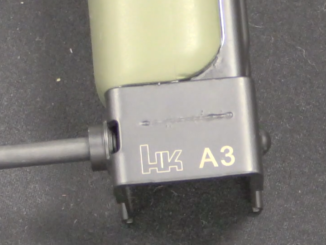In 2007, the British Army placed an order for 582 AI Arctic Warfare Super Magnum rifles chambered for the .338 Laua Magnum cartridge, formally adopting the model as the L115A3 sniper rifle. This followed special forces use of the .338 Accuracy International rifles in Afghanistan, where the A1 (fixed stock) and A2 (folding stock) models had both been given designations.With the adoption of the L115, the British retired all of their remaining L96A1 rifles, and moved to the .338 cartridge for all of their sniping equipment. At this same time, the SSIP (Sniper System Improvement Program) was improving and updating all the ancillary gear used with the guns – scopes, bipods, ballistic calculators and training programs, spotting scopes, and more. These remain the current British sniper weapon today, and they are quite formidable kit in properly trained hands.
Thanks to Steve Houghton for providing me access to this rifle! If you are interested in learning more, I highly recommend checking out Steve’s newly released book, “The British Sniper: A Century of Evolution“.




Seems to me that a system like this is getting into a similar space as light mortars (which may have a greater effective range but obviously less accuracy.)
Inside the range fan of, but not a similar space. The mortar is inherently an area weapon; you will not use one to take out a specific person, as British snipers did to kill an ISIL leader. Granted, PGM technology is changing that, but there’s a hell of a difference between having a couple of kg of high explosives go off vs. having 300 grains of cupro-nickle alloy go through someone’s head.
A sniper rifle is the military way of saying “f**k you”. A mortar round is the military way of saying “f**k you and all your close friends, indiscriminately”…
How would the fluting of the barrel affect accuracy?
I presume the fluting is a weight saving measure?
Here is an article on subject, you can find more on your own if you wish.
https://bisonballistics.com/articles/the-fluted-barrel-stiffness-and-rifle-accuracy
Apparently, as bullet is pushing its way thru the bore, it causes ‘ringing’ (dynamic response to material transfer resistance). This causes a miniscule vibration in barrel body. Btw., every metallic part (and some non-metallic too) have so called “natural frequency”; this is where it all starts.
https://en.wikipedia.org/wiki/Molecular_vibration
https://en.wikipedia.org/wiki/Molecular_vibration
This is a better reference, I apologise.
https://community.plm.automation.siemens.com/t5/Testing-Knowledge-Base/Natural-Frequency-and-Resonance/ta-p/498422
Fluting the barrel accomplishes a few things:
1) It stiffens the barrel in the same way an ‘I’ beam is stronger than just a square length of steel. This can dampen the harmonic vibrations as the bullet travels down the barrel, usually improving accuracy.
2) It provides more surface area to the exterior of the barrel and allows for better cooling. Keeping a barrel cool extends its life by reducing throat erosion. Getting the barrel extremely hot can cause groups to open and/or wander.
3) Fluting does reduce weight a little.
You really only start to see these benefits on heavy barrels with deep flutes. Shallow fluting on sporter barrels is more cosmetic than functional. And, like weighing cases, any improvement will only be seen by avid benchrest & PRS competitors.
Fluting doesn’t enhance the accuracy of the rifle. It does decrease weight though.
Is this weapon for sale?
I recently discovered that in November 2009 a British sniper made fatal hits on two Taliban machine gunners with this rifle at 2,475 meters, taking nine rounds to get the range. (Some accounts say he disabled their MG with a shot too.) This was 900 yards further than maximum recommended range; the bullets traveled for five seconds each. This distance was only subsequently exceeded by snipers firing .50-caliber rifles.